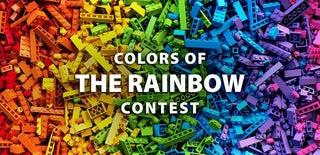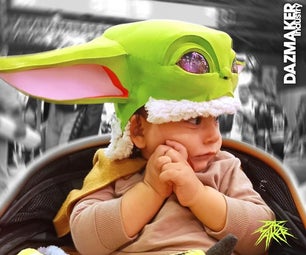Introduction: DIY Green Satin Pillow With Geometric Gold Foil Pattern
I've liked the gold-and-emerald-green combination for a long time, and recently I've seen a few glamorous cushions in these colours and it has inspired me to make one myself. I'm sure it's the first of many!
I chose a satin fabric to match the shine of the gold foil, and I made an envelope style cushion cover since this is the simplest to sew.
I hope you like the project :)
Supplies
- Fabric: I used bottle green 'Duchess Satin' fabric (polyester).
- DecoFoil Hot Melt Adhesive
- Decofoil Gold Transfer Sheet
- Iron & ironing board
- Sewing Machine & Thread
- Sewing Pins
- Cushion Insert
- Rotary Cutter (optional) & Cutting Mat
- Craft Knife
- Metal Ruler
- Tape Measure
- Disappearing/Magic Fabric Pen
- Pinking Shears (optional)
Step 1: Cut the Fabric Pieces
I bought a 12" x 15.5" cushion insert for this project, and I'm going to be using a 1/2" seam allowance, so each fabric piece will need to be 13" x 16.5" in size.
Basically, just add 1" to the length and 1" to the width.
You will need 3 identical pieces of fabric this size.
I measured out the first rectangle and drew the outline with a fabric pen. I then used a rotary cutter and metal ruler to cut along the lines. To make sure all of the pieces were the same, I then used this first piece of fabric as the template to cut out the next two.
Step 2: Mark Out the Pattern
Use your ruler & fabric pen to mark the centre of the top and bottom of one of the fabric pieces. This piece will be the front of the cushion.
In my case, this was 8.25" from the side.
Then cut the DecoFoil Adhesive sheet into 1 cm (or 3/8") strips. I used my craft knife and ruler to do this, and I needed 6 strips in total.
Step 3: Add the Adhesive Strips
Arrange the strips of adhesive, rough-side-down, where you want the line pattern to be (on the right side of the fabric). I wanted lines between the centre point marks and each corner of the rectangle.
Try and keep the lines straight if they're made up of more than 1 strip, and don't overlap the strips.
You'll need to mark which sections of the strips need to be removed to prevent them overlapping, and also mark where the strips overhang the fabric because you don't want the adhesive to stick to the ironing board underneath.
Cut off all of the excess adhesive.
Note that I also marked each full line with matching letters of the alphabet so that if all of the strips fall on the floor, I will still know where everything is supposed to go :)
Step 4: Transfer the Adhesive
Transfer the fabric and adhesive strips to the ironing board, making sure everything is placed correctly, and the adhesive is rough side down.
Put your iron on low-medium heat and follow the instructions on the pack of adhesive.
Included in the pack is a piece of parchment paper, and this needs to be placed carefully over the strips (without moving them) so that it is always in between the iron and the adhesive/fabric.
Hold the iron on every section of each adhesive strip for around 30 seconds. Move all around the design until all the adhesive has been ironed for the specified time.
Leave it to cool, then remove the backing from the strips.
Step 5: Shiny Foil Time
Cut strips of gold transfer sheet to cover all of the lines of adhesive. Make the foil a little wider than the adhesive lines, and feel free to overlap the strips.
I needed 7 strips this time to cover all of the adhesive.
Place the gold strips on top of the adhesive so that the shiny gold side is facing upwards.
Place the parchment paper over the foil and press with an iron, the same as we did with the adhesive, but this time press for a little longer; 30-40 seconds.
Do this for all sections of the foil and leave to cool.
Step 6: Cushion Back - Pressing
Take one of the other fabric pieces and fold one of the long edges onto the wrong side of the fabric to create a folded-over section. Press this fold in place.
Note: I made the folds all 3" wide in this step, however, I would recommend actually making all of the folds 2.5" wide instead as my cover only just overlapped enough.
Fold the edge over again, in the same direction & by the same amount, and press with the iron. So you've basically made a large double-fold hem.
Do the same for the other rectangle of fabric.
Step 7: Cushion Back - Sewing
Pin the double-fold hems in place on each fabric piece, then sew next to the edge, as shown. I've used a contrast thread but you would use a matching thread for this.
Step 8: Assemble & Sew
Place the patterned fabric piece right-side-up, and then place both of the other fabric pieces on top, right-side-down.
Line up the top and bottom edges. The double-fold hems should overlap a little.
Pin all of the way around, and then sew all of the way around too, using a 1/2" seam allowance.
Step 9: Finishing Touches
If you have pinking shears, you can now go around the edges to neaten them up a little, remove some bulk, and help prevent further fraying.
Then turn the cover right-side-out and put the cushion insert inside.
Since my hems didn't overlap by a large amount, I also added a small semi-circle of self-adhesive Velcro to the inside of the flap.
Step 10: The End!
And that's it, the cushion is complete!
I hope you enjoyed this Instructable :D

Participated in the
Colors of the Rainbow Contest














Comments